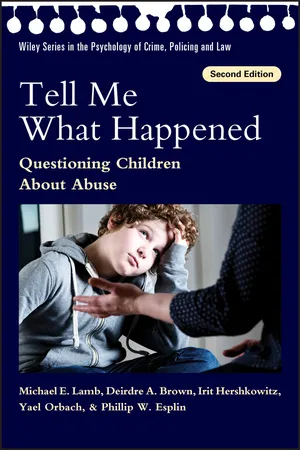
Tell Me What Happened
Questioning Children About Abuse
- English
- ePUB (mobile friendly)
- Available on iOS & Android
Tell Me What Happened
Questioning Children About Abuse
About this book
Represents a scholarly and ambitious attempt to improve the quality of interviews received by the courts and minimize the risks of miscarriages of justice, for victims and defendants
This book updates the previous review of research on children's testimony—reexamining and readdressing how the quality of information provided by young witnesses is affected by the way they are questioned. Drawing upon both experimental and field studies conducted in different countries, it summarizes evidence supporting the effectiveness of the National Institute for Child Health and Human Development (NICHD) Protocol and showcases the Protocol's superiority over other current interviewing techniques for eliciting detailed and forensically useful content from child complainants.
Written with both child protection professionals and researchers in mind, Tell Me What Happened: Questioning Children About Abuse offers advice and opinions drawn from actual investigative interviews as well as academic research. Its insightful chapters cover: children's testimony; interview and questioning strategies; how investigators typically interview alleged victims; the NICHD Investigative Interview Protocols; the impact that following the Protocol has on interviews and children's responses; interviewing victims under the age of six; interviewing children with developmental disabilities; using tools and props to complement the Protocol; training and maintaining good interviewing practices; and more.
- Provides a primary source of guidance practitioners and professionals involved in child protection
- Updates guidance for interviewers by adding consideration of emotional and motivational factors to better understand children's behavior during interviews
- Integrates the substantial body of research published over the last decade and reflects upon questions that the field should continue to address
Tell Me What Happened: Questioning Children About Abuse deserves to be read by all practitioners involved in child protection, whether as investigators, interviewers, judges, or lawyers.
Frequently asked questions
- Essential is ideal for learners and professionals who enjoy exploring a wide range of subjects. Access the Essential Library with 800,000+ trusted titles and best-sellers across business, personal growth, and the humanities. Includes unlimited reading time and Standard Read Aloud voice.
- Complete: Perfect for advanced learners and researchers needing full, unrestricted access. Unlock 1.4M+ books across hundreds of subjects, including academic and specialized titles. The Complete Plan also includes advanced features like Premium Read Aloud and Research Assistant.
Please note we cannot support devices running on iOS 13 and Android 7 or earlier. Learn more about using the app.
Information
1
Interviewing Children About Abuse: An Overview and Introduction
A mother contacts Child Protective Services, concerned about a comment her daughter, Sarah (3 years old), made during bath time. Sarah pointed to her vagina and said “Daddy does that to me”.. Sarah’s parents recently separated, and her father lives out of town, only seeing her one weekend a month. Sarah’s class has recently been working through a trial of an educational model about “good touch, bad touch.” When Sarah was asked during an investigative interview what she was there to talk about she replied, “Mummy is mad because Daddy rubbed me there and that’s bad touch.”Ben (4 years) recently developed an infection around his bottom. During examination his doctor noted that Ben appeared to have some partially healed abrasions that might be consistent with abuse. During the rapport building stage of an investigative interview Ben talked about his interest in pirates. During the substantive phase Ben told the interviewer that his friend Joey (8 years) “stabbed him in the butt with his sword and then I punched him in the face and he died.”Theresa (6 years) lives with her mother and stepfather (Shane). She often stays up late with them and falls asleep on the couch while they watch television. Two weekends a month Theresa stays with her father (Steve), stepmother (Melissa), and stepsister (Molly—4 years). Melissa became concerned when she observed Theresa playing with two dolls, one on top of the other, saying “see Molly, this is how you show someone you love them, this is how you are a real special girl.” Melissa asked Theresa how she knew that, and Theresa replied “I’m Shane’s special girl.” Melissa told Theresa that grownups should not love children like that and she needed to tell her father that Shane was playing with her the wrong way. An investigation was initiated.
THE BACKGROUND: INTERVIEWING AND CHILD DEVELOPMENT
Table of contents
- Cover
- Table of Contents
- About the Authors
- Series Preface
- Preface
- 1 Interviewing Children About Abuse
- 2 Contributions to Children’s Testimony
- 3 Contributions to Testimony: Preparation for the Interview and Questioning Strategies
- 4 How do Investigators Typically Interview Alleged Victims?
- 5 The NICHD Investigative Interview Protocols for Young Victims and Witnesses
- 6 When Interviewers Follow the Protocol, What Impact Does it Have on Their Interviewing and on Children’s Responding?
- 7 Interviewing Suspected Victims under Six Years of Age
- 8 Interviewing Children with Developmental Disabilities
- 9 The Revised Protocol
- 10 Using Tools and Props to Complement the Protocol
- 11 Training and Maintaining Good Interviewing Practice
- 12 Case‐related Outcomes When the Protocol is Used
- 13 Progress to Date and the Challenges Ahead
- Revised Investigative Interview Protocol: Version 2018
- References
- Index
- End User License Agreement